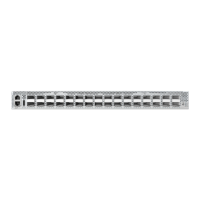C
HAPTER
21
| Multicast Routing
Configuring Global Settings for Multicast Routing
– 545 –
CLI REFERENCES
◆ "show ip mroute" on page 1086
PARAMETERS
These parameters are displayed in the web interface:
Show Summary
◆ Group Address – IP group address for a multicast service.
◆ Source Address – Subnetwork containing the IP multicast source.
◆ Source Mask – Network mask for the IP multicast source. (Note that
the switch cannot detect the source mask, and therefore displays
255.255.255.255 in this field.)
◆ Interface – Upstream interface leading to the upstream neighbor.
PIM creates a multicast routing tree based on the unicast routing table.
If the related unicast routing table does not exist, PIM will still create a
multicast routing entry, displaying the upstream interface to indicate
that this entry is valid. This field may also display “Register” to indicate
that a pseudo interface is being used to receive PIM-SM register
packets. This can occur for the Rendezvous Point (RP), which is the root
of the Reverse Path Tree (RPT). In this case, any VLAN receiving
register packets will be converted into the register interface.
◆ Owner – The associated multicast protocol (PIM-DM, PIM-SM, IGMP
Proxy).
◆ Flags – The flags associated with each routing entry indicate:
■
Forward – Traffic received from the upstream interface is being
forwarded to this interface.
■
Local – This is the outgoing interface.
■
Pruned – This interface has been pruned by a downstream
neighbor which no longer wants to receive the traffic.
Show Details
◆ Group Address – IP group address for a multicast service.
◆ Source Address – Subnetwork containing the IP multicast source.
◆ Source Mask – Network mask for the IP multicast source.
◆ Upstream Neighbor – The multicast router (RPF Neighbor)
immediately upstream for this group.
◆ Upstream Interface – Interface leading to the upstream neighbor.
◆ Up Time – Time since this entry was created.

